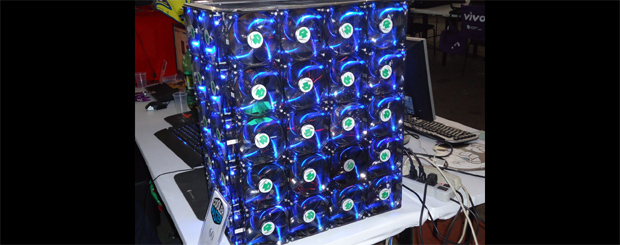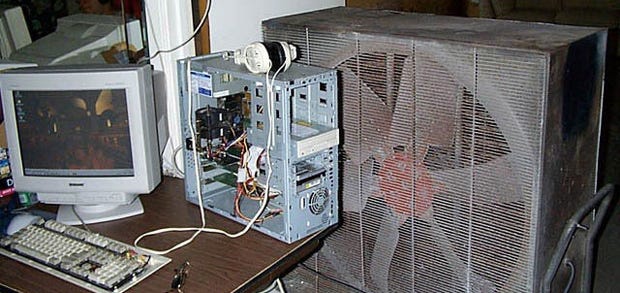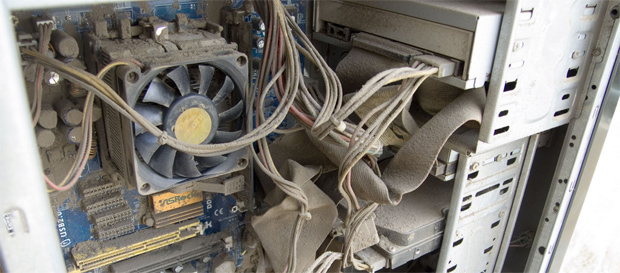How To Keep Your PC Cool
More frames for your games
Lordy, it's hot. Well, hot if you're British. Call it seasonable by sticky Manhattan standards or a bracing Spring cold snap for Aussies. But it's over 90 in old money and the nation's infrastructure is melting. Well, my kitchen PC has just fallen over again with a CPU thermal trip. So, as far as I'm concerned, it's chaos out there. Which reminds me. We've never really discussed how to keep your PC cool. Given gaming is probably the only thing most of us do that loads up both CPU and graphics, this is an oversight. So here are my top eight tips for keeping your PC cool. Most of them won't cost you a a penny and they could well help your games run faster.
Before we start, keeping our PC cool isn't just about stopping it from falling over. The performance of modern processors and GPUs with their various 'Turbo' modes can vary substantially according to temperature. So a cool PC will often be a fast PC. In other words, more frames for your games.
I'd also emphasise that this isn't just a guide to spending lots of money on fancy cooling kit. Most of the tips below will cost you nothing. What's more, even relatively high end cooling kit is low cost compared to most PC components...
1. Keep it clean
Before you worry about upgrades or tweaks, just keeping the poor thing moderately clean will make a huge difference. The great enemy, of course, is dust. It builds up astonishingly quickly and will absolutely knacker the ability of components like fans and heat sinks to keep things cool.
Thus, your first step is to de-dust. Things to do include unplugging and shutting down your PC before you begin cleaning. I'd go for a little dismantling, too, to get at tricky to reach places. Make sure all fans and heat sinks have been dusted carefully, including the various vents and ports.
As for don'ts, they include trying to do this with the PC running and fans whirling, using water or sprays. Actually, there is an exception to using water and sprays. They can be used on the passive part of a CPU cooler once it's been entirely extracted from the PC and separated from any electronics like fans or fan controllers. And it is incidentally a very good idea to remove the cooler entirely to give it a proper clean.
Vacuum cleaners can also be a huge help, but don't just ram a high-suction nossle blindly into your PC. It won't end well. So do take great care.
2. Reseat your critical coolers
If you've de-dusted properly, you'll have removed your CPU cooler to give the fins a proper going over. This is also your chance to ensure that the cooler is properly seated with decent quality thermal paste when it goes back in.
A small tube of paste from an online PC shop is a very small investment but will pay dividends long term. As for how much paste, I favour multiple small dots place strategically around the CPU lid / heat spreader rather than a big dollop in the middle. If you have paste oozing from the sides once the heat sink is seated, you've overdone it.
3. Go with the flow
Adequate air flow is absolutely critical. The reason my kitchen PC is prone to thermal borkery is down to inadequate airflow in a hot environment. It's squeezed into a tight corner with the main vents pretty well blocked. If it was a gaming rig, it would be a disaster.
Achieving good airflow requires attention both inside and outside your rig. First, make sure there's enough space between your box and any external barriers to allow air to flow properly. In other words, do not ram it right up against the wall.
 More fans is usually a good idea, but they do need to be pointing in the right direction...
More fans is usually a good idea, but they do need to be pointing in the right direction...
Inside, do your best to give each component decent breathing space. You'll often have, for instance, more than one slot that your video card can plug into. Don't stack PCI and PCI Express cards closely together unless you absolutely have to. Some strategically-placed ties can help with the rats' nest of cabling, too.
Also, in an ideal world you'll have case fans at the front sucking in cool air and fans at the rear blowing out hot air for optimal flow across all your key components. Try not to have the fans fighting each other.
4. Use everything you got!
I'd be willing to bet an awful lot of you have case fans that aren't plugged in. Well, plug them in and use them! Your motherboard will almost definitely have plenty of spare fan ports.
If you're worried about noise, 120mm-plus case fans do not generate a great deal of din and will help hugely when it comes to getting hot air actually out of your PC. Otherwise, your CPU and graphics coolers will simply be pumping hot air round in circles. Hopeless.
On the subject of noise...
5. Have a proper play with your BIOS settings
Your options will vary pretty wildly depending on your motherboard and cooling hardware. But you will have options, that's the critical thing. So jump into your BIOS and find out what they are. Very likely you'll find all manner of controls for fan speeds and thermal triggers. Put a little gumption into it and you'll soon find a decent compromise between cool and quiet.
 Even the crappy Intel mobo in my kitchen PC has a tolerable range of fan controls.
Even the crappy Intel mobo in my kitchen PC has a tolerable range of fan controls.
Most motherboards these days also offer Windows apps giving you instant access to settings - check the manufacturer's website for a download. That can be handy, for instance, if you want to run your rig super-silent most of the time and quick-jump into max cooling mode whenever you fire up a game.
6. Buy a better CPU cooler
If you're running some kind of skanky OEM cooler that came with your CPU or a cheap PC several upgrade cycles past, do yourself a favour and buy a decent cooler. Roughly £30 / $40 buys you a really decent heatsink and fan combo with multi-socket compatibility that will last you several upgrade cycles. It's a tiny investment given the long-term upsides. If you want examples, there are literally zillions to choose from. But a safe bet would be something like Cooler Master Hyper 612v2. Just make sure to do your due diligence in terms of space around your CPU socket and indeed your case. Make sure it'll fit, in other words.
As for upgrading your graphics cooling, it's a little more complicated, though hardly beyond the wit of most RPSers. If your card has the reference cooler, odds are it can be improved upon greatly. If it's already some kind of custom design by the card maker (and many now are), I'd probably leave it alone.
7. Consider water cooling
I'm a big fan of water cooling. Today's closed loop kits are affordable, easy to fit, zero maintenance and just bloody effective. Not much more than £50 / $60 will get you a decent single-fan water cooler with a 120mm radiator. You will need to check compatibility with your case, in terms of both fittings and space. But once you've gone water, you won't want to go back.
 Corsair's H55 is a viable Water cooling is a perfectly viable £50 / $60 water cooler.
Corsair's H55 is a viable Water cooling is a perfectly viable £50 / $60 water cooler.
8. Don't go passive
This may split opinion. But I've tried using huge passive (i.e. fanless) heat sinks for my CPU and never been entirely happy. In any case, a good water cooler is so very quiet, the advantage in terms of noise of a passive CPU cooler is marginal. So, don't bother.
So that's it, my top eight tips for a cooler, faster PC. Shout out your own tips, tricks and favourite cooling clobber below.
P.S. Anyone for tennis?










